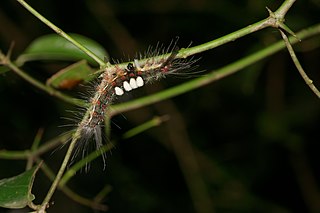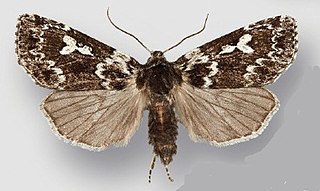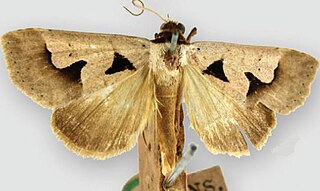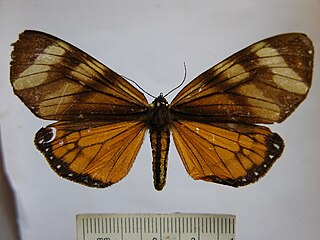
The Lymantriinae are a subfamily of moths of the family Erebidae.
The Catocalini are a tribe of moths in the family Erebidae. Adults of many species in the tribe are called underwing moths due to their vividly colored hindwings that are often covered by contrastingly dark, drab forewings.

The Calpinae are a subfamily of moths in the family Erebidae. This subfamily includes many species of moths that have a pointed and barbed proboscis adapted to piercing the skins of fruit to feed on juice, and in the case of the several Calyptra species of vampire moths, to piercing the skins of mammals to feed on blood. The subfamily contains some large moths with wingspans longer than 5 cm (2 in).

Catephia alchymista, the alchymist, is a species of moth in the family Erebidae. The species is found in Southern and Central Europe up to the Caucasus.

Xestia perquiritata, the boomerang dart, is a moth of the family Noctuidae. It is found across North America from Newfoundland, Labrador and northern New England, west to central Yukon, British Columbia and Washington. There are several disjunct populations, including one in the Great Smoky Mountains National Park and the Rocky Mountains in Colorado and a coastal bog in central Oregon.

Latebraria amphipyroides is a species of moth in the family Erebidae. The species is found in southern North America and Central America, south at least to Cuba and Costa Rica.
The laurentine idia is a species of litter moth of the family Erebidae. It is found from central New York, south to the mountains of North Carolina.

Borearctia menetriesii is a moth of the family Erebidae. It is found in Karelia, Oktyabrskoe, north-eastern Kazakhstan, Altai Mountains, Sayan Mountains, Evenkia, Yakutia, the central Amur region, Primorsky Krai and central Sakhalin. It was believed to be extinct in Fennoscandia, but the species has been recently recorded in Finland. This species is characterized by the fact that they never come to light; such behavior is atypical in the family of Arctiidae.

Baniana minor is a species of moth of the family Erebidae. It occurs in open woodland/grassland scrub habitats in southeastern Arizona and also occurs, probably in similar habitats in the Guanacaste Province in Costa Rica.

Baniana significans is a species of moth of the family Erebidae. It is found in Cuba and Santo Domingo.

Baniana gobar is a species of moth of the family Erebidae. It is found in Mexico.

The Erebinae are a subfamily of moths in the family Erebidae. Erebine moths are found on all continents except Antarctica, but reach their greatest diversity in the tropics. While the exact number of species belonging to the Erebinae is not known, the subfamily is estimated to include around 10,000 species. Some well-known Erebinae include Underwing moths (Catocala), and Witch moths (Thermesiini). Many of the species in the subfamily have medium to large wingspans, up to nearly 30 cm in the White Witch moth, which has the widest wingspan of all Lepidoptera. Erebine caterpillars feed on a broad range of plants; many species feed on grasses and legumes, and a few are pests of castor bean, sugarcane, rice, as well as pistachios and blackberries.
Schrankia macula, the black-spotted schrankia moth, is a species of moth of the family Erebidae. It is found from North America to Central America.

Cycnia oregonensis is a moth in the family Erebidae. It is found in most of North America, from coast to coast and from the border with Mexico north to central Saskatchewan and Nova Scotia.

Fishia yosemitae, the dark grey fishia or grey fishia, is a moth in the family Noctuidae. It is found from central Alberta to Colorado in the Rocky Mountain and Great Plains regions. It is also found in eastern, central, and southern California, as well as in the Intermountain region. The habitat consists of dry open areas, including open ponderosa pine forests, juniper woodlands and sagebrush steppe at low to middle elevations.

Dysschema eurocilia is a moth of the family Erebidae. It is a common species throughout
tropical America, where it has been recorded from the Antilles, Central America and South America.
The Anobinae are a subfamily of moths in the family Erebidae. Common morphological characteristics of Anobine moths include a dark head and prothoracic collar, lighter color on the thorax, and either bipectinate antennae or antennae with flagellomeral setae in males.
The Boletobiinae are a subfamily of moths in the family Erebidae, containing about 956 species.
Deinopa angitia is a species of owlet moths in the family Erebidae. It is found in Central America and North America.
















